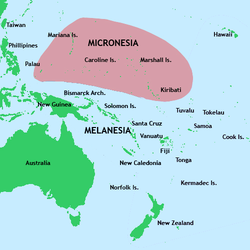- Micronesia
-
This article is about the greater region. For the independent state, see Federated States of Micronesia.
Micronesia is a subregion of Oceania, comprising thousands of small islands in the western Pacific Ocean. It is distinct from Melanesia to the south, and Polynesia to the east. The Philippines lie to the west, and Indonesia to the southwest.
The name Micronesia derives from the Greek mikros (μικρός), meaning small, and nesos (νῆσος), meaning island. The term was first proposed to distinguish the region in 1831 by Jules Dumont d'Urville.
Contents
Geography
Associated islands
The following islands and groups of islands are considered part of Micronesia:
- Banaba, an outlier of
 Kiribati
Kiribati - Gilbert Islands, which forms part of
 Kiribati
Kiribati - Mariana Islands, politically divided between
 Guam and the
Guam and the  Northern Mariana Islands
Northern Mariana Islands  Marshall Islands
Marshall Islands- Caroline Islands, politically divided between
 Palau and the
Palau and the  Federated States of Micronesia
Federated States of Micronesia  Nauru
Nauru Wake Island, a United States Minor Outlying Island
Wake Island, a United States Minor Outlying Island
Total Land Area: 1,229.95 square miles (3,185.6 km2)
History
The only empire known to have originated in Micronesia was based in Yap.
Much of the area came under European domination quite early. In the early 17th Century Spain colonized Guam, the Northern Marianas, and the Caroline Islands (what would later become the Federated States of Micronesia and Palau), creating the Spanish East Indies, which was governed from the Spanish Philippines until the Spanish-American War in 1898.
Full European colonization did not come, however, until the early 20th century, when the area would be divided between:
- the United States, which took control of Guam following the Spanish-American War of 1898, and colonized Wake Island;
- Germany, which took Nauru and bought the Marshall, Caroline, and Northern Mariana Islands from Spain; and
- the British Empire, which took the Gilbert Islands (Kiribati).
During the World War I, Germany's Pacific island territories were seized and they became League of Nations Mandates in 1923. Nauru became an Australian mandate, while Germany's other territories in Micronesia were given as a mandate to Japan and were named the South Pacific Mandate. Following Japan's defeat in the Second World War, its mandate became a United Nations Trusteeship, the Trust Territory of the Pacific Islands, ruled by the United States.
Today, most of Micronesia are independent states, except for Guam and Wake Island, which are U.S. territories, and for the Northern Mariana Islands, which are a U.S. commonwealth.
People
The people today form many ethnicities, but are all descended from and belong to the Micronesian culture. The Micronesian culture was one of the last native cultures of the region to develop. It developed from a mixture of Melanesians, Polynesians, and Filipinos. Because of this mixture of descent, many of the ethnicities of Micronesia feel closer to some groups in Melanesia, Polynesia or the Philippines. A good example of this are the Yapese who are related to Austronesian tribes in the Northern Philippines.[1]
Languages
The native languages of the various Micronesian indigenous peoples are classified under the Austronesian language family. Almost all of these languages belong to the Oceanic branch of this family, and mostly to the Micronesian languages division within that branch; however, two exceptions are noted in western Micronesia, which are Western Malayo-Polynesian languages:
- Chamorro in the Mariana Islands
- Palauan in Palau.
These are apparently no more closely related to Micronesian languages than they are to languages of the Philippines, Malaysia, and Indonesia (Kirch, 2000: pp. 166–167).
On the eastern edge of the Federated States of Micronesia, the languages Nukuoro and Kapingamarangi represent an extreme westward extension of Polynesian.
Regional organizations
The region is home to the Micronesian Games, a quadrennial international multi-sport event involving all Micronesia's countries and territories except Wake Island.
In September 2007, journalists in the region founded the Micronesian Media Association.[2]
See also
Main article: Outline of MicronesiaReferences
- ^ http://www.everyculture.com/wc/Mauritania-to-Nigeria/Micronesians.html
- ^ Regional journalists form Micronesian media group, Saipan Tribune, 26 September 2007
Further reading
- Kirch, Patrick Vinton (2000). On the Road of the Winds. An Archaeological History of the Pacific Islands before European Contact. University of California Press. pp. 166–167. ISBN 0-520-22347-0.
- Goetzfridt, Nicholas J. and Karen M. Peacock. (2002) Micronesian Histories: An Analytical Bibliography and Guide to Interpretations. Westport. CT: Greenwood Press.
External links
Countries and territories of Oceania Sovereign states Australia · Chile (Easter Island · Juan Fernández Islands) · East Timor (Timor-Leste) · Fiji · Indonesia · Kiribati · Marshall Islands · Federated States of Micronesia · Japan (Bonin Islands) · Nauru · New Zealand · Palau · Papua New Guinea · Samoa · Solomon Islands · Tonga · Tuvalu · United States (Hawaii · Palmyra Atoll) · Vanuatu
Dependencies and other territories AustraliaFranceNew ZealandUnited KingdomUnited StatesRegions of the world 
Africa Northern · Sub-Saharan (Central · Southern · Western · Eastern) 
Oceania Australasia (Australia) · Melanesia · Micronesia · Polynesia 
America North (Northern • Middle • Central • Caribbean) · South (Southern • Northern • Western) · Anglo · Latin 
Polar Arctic · Antarctic 
Asia Central · Eastern (Northeastern) · Northern · Southeastern · Southern (Indian subcontinent) · Western (Middle East) 
Oceans World · Arctic · Atlantic · Indian · Pacific · Southern 
Europe Central · Eastern · Northern · Southeastern · Southern · Western 
Seas List of seas Related Continents of the world · List of seas · Physical EarthCategories:- Biodiversity hotspots
- Micronesia
- Banaba, an outlier of
Wikimedia Foundation. 2010.


